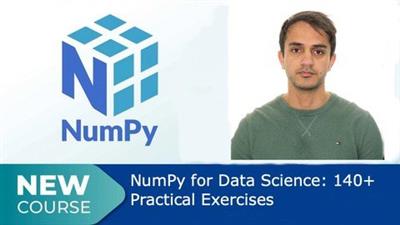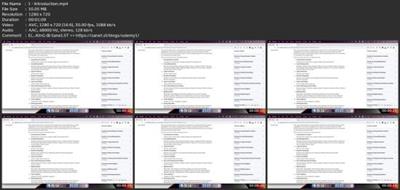O
0

Numpy For Data Science: 140+ Practical Exercises In Python
Published 2/2023
MP4 | Video: h264, 1280x720 | Audio: AAC, 44.1 KHz
Language: English | Size: 221.42 MB | Duration: 0h 47m
Enhance your Python programming and data science abilities by completing more than 140+ NumPy exercises.
Published 2/2023
MP4 | Video: h264, 1280x720 | Audio: AAC, 44.1 KHz
Language: English | Size: 221.42 MB | Duration: 0h 47m
Enhance your Python programming and data science abilities by completing more than 140+ NumPy exercises.
What you'll learn
Develop a strong understanding of the fundamental concepts and capabilities of numpy , including array creation, indexing, slicing, reshaping etc
Become proficient in using various numpy functions and methods to manipulate and analyze data stored in arrays, such as aggregating, sorting or filtering.
Learn how to use numpy to perform advanced numerical computations, such as linear algebra
Gain practical experience applying numpy in real-world data analysis and scientific computing scenarios
Requirements
Basic knowledge of python and numpy
Description
This course will provide a comprehensive introduction to the NumPy library and its capabilities. The course is designed to be hands-on and will include over 140+ practical exercises to help learners gain a solid understanding of how to use NumPy to manipulate and analyze data. The course will cover key concepts such as :Array Routine CreationArange, Zeros, Ones, Eye, Linspace, Diag, Full, Intersect1d, TriArray ManipulationReshape, Expand_dims, Broadcast, Ravel, Copy_to, Shape, Flatten, Transpose, Concatenate, Split, Delete, Append, Resize, Unique, Isin, Trim_zeros, Squeeze, Asarray, Split, Column_stackLogic FunctionsAll, Any, Isnan, EqualRandom SamplingRandom.rand, Random.cover, Random.shuffle, Random.exponential, Random.triangularInput and OutputLoad, Loadtxt, Save, Array_strSort, Searching and CountingSorting, Argsort, Partition, Argmax, Argmin, Argwhere, Nonzero, Where, Extract, Count_nonzeroMathematicalMod, Mean, Std, Median, Percentile, Average, Var, Corrcoef, Correlate, Histogram, Divide, Multiple, Sum, Subtract, Floor, Ceil, Turn, Prod, Nanprod, Ransom, Diff, Exp, Log, Reciprocal, Power, Maximum, Square, Round, RootLinear AlgebraLinalg.norm, Dot, Linalg.det, Linalg.invString OperationChar.add, Char.split. Char.multiply, Char.capitalize, Char.lower, Char.swapcase, Char.upper, Char.find, Char.join, Char.replace, Char.isnumeric, Char.count.This course is designed for data scientists, data analysts, and developers who want to learn how to use NumPy to manipulate and analyze data in Python. It is suitable for both beginners who are new to data science as well as experienced practitioners looking to deepen their understanding of the NumPy library.
Overview
Section 1: Introduction
Lecture 1 Introduction
Lecture 2 Welcome to Numpy for Data Science
Lecture 3 Numpy
Section 2: Array Routine Creation
Lecture 4 Solution 1
Lecture 5 Solution 2
Lecture 6 Solution 3
Lecture 7 Solution 4
Lecture 8 Solution 5
Lecture 9 Solution 6
Lecture 10 Solution 7
Lecture 11 Solution 8
Lecture 12 Solution 9
Lecture 13 Solution 10
Lecture 14 Solution 11
Lecture 15 Solution 12
Section 3: Array Manipulation
Lecture 16 Solution 1
Lecture 17 Solution 2
Lecture 18 Solution 3
Lecture 19 Solution 4
Lecture 20 Solution 5
Lecture 21 Solution 6
Lecture 22 Solution 7
Lecture 23 Solution 8
Lecture 24 Solution 9
Lecture 25 Solution 10
Lecture 26 Solution 11
Lecture 27 Solution 12
Lecture 28 Solution 13
Lecture 29 Solution 14
Lecture 30 Solution 15
Lecture 31 Solution 16
Lecture 32 Solution 17
Lecture 33 Solution 18
Lecture 34 Solution 19
Lecture 35 Solution 20
Lecture 36 Solution 21
Lecture 37 Solution 22
Lecture 38 Solution 23
Section 4: Logic Functions
Lecture 39 Solution 1
Lecture 40 Solution 2
Lecture 41 Solution 3
Lecture 42 Solution 4
Lecture 43 Solution 5
Lecture 44 Solution 6
Section 5: Random Sampling
Lecture 45 Solution 1
Lecture 46 Solution 2
Lecture 47 Solution 3
Lecture 48 Solution 4
Lecture 49 Solution 5
Lecture 50 Solution 6
Lecture 51 Solution 7
Lecture 52 Solution 8
Section 6: Input and Output
Lecture 53 Solution 1
Lecture 54 Solution 2
Lecture 55 Solution 3
Lecture 56 Solution 4
Lecture 57 Solution 5
Lecture 58 Solution 6
Section 7: Sorting, Searching & Counting
Lecture 59 Solution 1
Lecture 60 Solution 2
Lecture 61 Solution 3
Lecture 62 Solution 4
Lecture 63 Solution 5
Lecture 64 Solution 6
Lecture 65 Solution 7
Lecture 66 Solution 8
Lecture 67 Solution 9
Lecture 68 Solution 10
Lecture 69 Solution 11
Lecture 70 Solution 12
Lecture 71 Solution 13
Lecture 72 Solution 14
Lecture 73 Solution 15
Lecture 74 Solution 16
Lecture 75 Solution 17
Lecture 76 Solution 18
Lecture 77 Solution 19
Lecture 78 Solution 20
Lecture 79 Solution 21
Lecture 80 Solution 22
Lecture 81 Solution 23
Lecture 82 Solution 24
Lecture 83 Solution 25
Lecture 84 Solution 26
Lecture 85 Solution 27
Section 8: Linear Algebra
Lecture 86 Solution 1
Lecture 87 Solution 2
Lecture 88 Solution 3
Lecture 89 Solution 4
Lecture 90 Solution 5
Lecture 91 Solution 6
Lecture 92 Solution 7
Lecture 93 Solution 8
Lecture 94 Solution 9
Lecture 95 Solution 10
Lecture 96 Exercise 11
Section 9: Mathematical
Lecture 97 Solution 1
Lecture 98 Solution 2
Lecture 99 Solution 3
Lecture 100 Solution 4
Lecture 101 Solution 5
Lecture 102 Solution 6
Lecture 103 Solution 7
Lecture 104 Solution 8
Lecture 105 Solution 9
Lecture 106 Solution 10
Lecture 107 Solution 11
Lecture 108 Solution 12
Lecture 109 Solution 13
Lecture 110 Solution 14
Lecture 111 Solution 15
Lecture 112 Solution 16
Lecture 113 Solution 17
Lecture 114 Solution 18
Lecture 115 Solution 19
Lecture 116 Solution 20
Lecture 117 Solution 21
Lecture 118 Solution 22
Lecture 119 Solution 23
Lecture 120 Solution 24
Lecture 121 Solution 25
Lecture 122 Solution 26
Lecture 123 Solution 27
Lecture 124 Solution 28
Lecture 125 Solution 29
Lecture 126 Solution 30
Lecture 127 Solution 31
Lecture 128 Solution 32
Section 10: String Operations
Lecture 129 Solution 1
Lecture 130 Solution 2
Lecture 131 Solution 3
Lecture 132 Solution 4
Lecture 133 Solution 5
Lecture 134 Solution 6
Lecture 135 Solution 7
Lecture 136 Solution 8
Lecture 137 Solution 9
Lecture 138 Solution 10
Lecture 139 Solution 11
Lecture 140 Solution 12
Lecture 141 Solution 13
Lecture 142 Solution 14
Lecture 143 Solution 15
Lecture 144 Solution 16
Section 11: Installation & Configuration
Lecture 145 Intro
Lecture 146 What is Google Colaboratory?
Lecture 147 Google Colab and Github
Lecture 148 What is Anaconda Python?
Lecture 149 How to install Anaconda Python on Mac?
Lecture 150 How to install Anaconda Python on Windows?
Lecture 151 How to use Anaconda Navigator
Lecture 152 Jupyter and Spyder
A hands-on 140+ exercise course on numpy is suitable for anyone interested in learning or improving their skills in data analysis, scientific computing, or machine learning using numpy. This course would be especially useful for data scientists, engineers, researchers, or analysts who want to learn how to use numpy to manipulate, analyze, and visualize data efficiently.,This course would be a good fit for beginners who want to learn the basics of numpy as well as advanced users who want to deepen their understanding of numpy and learn more advanced techniques. However, some basic knowledge of programming and Python is typically required to get the most out of a numpy course.,If you have a specific application or project in mind that requires the use of numpy, a 140+ exercise course on numpy can help you acquire the skills and knowledge you need to complete that project effectively. It can also be a good way to prepare for more advanced courses or certifications in data science or machine learning, as numpy is a fundamental library used in many data analysis and machine learning tasks.

Download link
rapidgator.net:
You must reply in thread to view hidden text.
uploadgig.com:
You must reply in thread to view hidden text.
nitroflare.com:
You must reply in thread to view hidden text.
